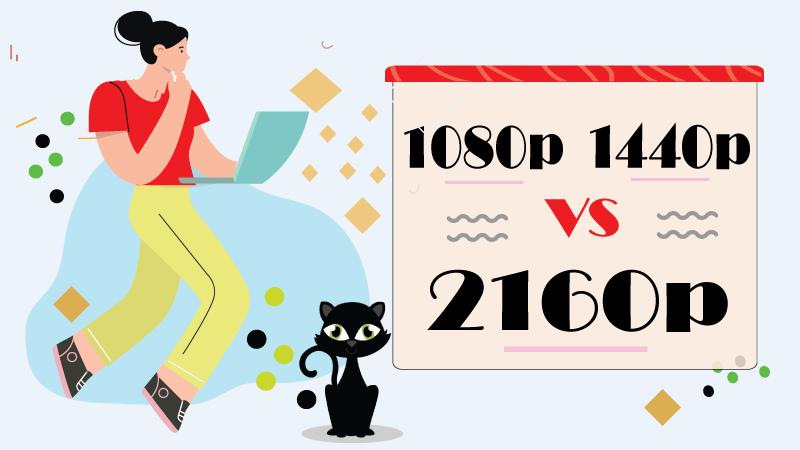The world is full of different screen resolutions—the most confusing and common ones: 1080p, 1440p, and 2160p (4k)—making it challenging for people which one is right for their needs. So let’s discuss it and compare with each other.

The HD battle is becoming more intense because of different screen resolutions on the market—mainly 1080p, 1440p, and 2160p. Over time, discoveries and successes have been recorded, making it really difficult to choose your needs’ best resolution.
We all have different viewing resolution needs and requirements. Choosing the best becomes a herculean task when you consider the various choices available.
In this article, I would be outlining the more popular resolution and making a Verdict on what is relevant for different categories of users. But before I get into (1080p vs 1440p vs 2160p), let me define what a video resolution is.
What is a Video Resolution?
This is simply the number of pixels in each dimension that can be displayed.
The more the number of pixels, the higher the resolution, and the crisper the images would be. Now, you know why your version of wonder woman 1948 wasn’t as clear as the one in the cinema. It’s all down to the resolution.
When it comes to video, it is safe to say that a lot rises and falls on the resolution. Having the right resolution can really make your viewing experience better.
Unveiling The Competitors: 1080p vs 1440p vs 2160p (4K)
This article will review three different video resolutions: 1080p, 1440p, and 2160p. The aim is to clearly define each and find out which is better for you in different scenarios.
1080p: How Many Pixels?
This is the 1920 x 1080 resolution, also known as Full High Definition (FHD) option. In this resolution, 1920 pixels are displayed horizontally, while 1080 pixels are displayed vertically.
It displays a total of 2,073,600 pixels, which can be rendered as 2.1 megapixels, and also known as 2k and is the standard high definition resolution for most devices, including HDTVs, projectors, and Mobile devices. It is also the HD resolution with the highest level of content.
1440p
This is the 2560 x 1440 resolution known as Widescreen Quad High Definition (WQHD or QHD) option. In this resolution, 2560 pixels are displayed horizontally, while 1440 pixels are displayed vertically.
It displays 3,686,400 pixels and is the middle ground between 2k (that is 1080p) and 4k. It is mostly used as a graphic display resolution in smartphones, computers, and gaming consoles.
2160p
This is the 3840 x 2160 resolution, which is also known as Ultra High Definition (UHD) option. In this resolution, 3840 pixels are displayed horizontally, while 2160 pixels are displayed vertically. It is also known as 4K. Cinematographers mostly use this resolution for movie making.
Comparing the Resolutions?
When it comes to choosing which is better, it becomes really dicey. There would be different needs for different resolutions, and in each particular need, one resolution will fair better than the others. We will go through all of the various instances in which each resolution would be king.
Clarity
When talking about clarity, it is in reference to how well each resolution can clearly display content. This determines how realistic and vivid the display will be.
It’s not difficult to answer this particular question. 2160p resolution is the better resolution, followed by 1440p, and then 1080p. 2160p will render the best and clearest image among the three different resolutions.
Affordability
When it comes to affordability, it’s a simple reference to how expensive each resolution is in the market. Affordability is one significant factor in comparing all three resolutions.
The more affordable resolution is 1080p. This resolution is the oldest among the three. This makes the other two newer and more expensive. So when it boils down to affordability, 1080p takes the day.
Content availability
This is one major factor that cannot be ignored. Some of these resolutions have more content that runs on them. When it comes to content availability, it might be a little bit dicey, though.
If you are referring to movie content, then 1080p is the resolution with the most availability. However, if you are looking for computer gaming graphics, 1440p will take the front seat as most games work on that resolution. 2160p, on the other hand, is the unknown on the list. While it’s full of so much potential, little or no content is available in that resolution.
Usability
The different resolutions have their other fortes (at the moment, at least). 1080p is mostly used for Television broadcast, Smartphones, and Web-based content placed on streaming sites like Netflix and YouTube.
It is also used in most consumer-grade televisions, projectors, gaming consoles, and computer monitors. 1440p, on the other hand, is heavy on gaming. While it’s used on smartphones and some TVs, it is basically the standard for gaming.
2160p is mostly used for shooting movies because of the details that it can capture. Movies are also rendered in this resolution. Some TVs are made in these resolutions since it can offer better picture quality.
When all three are compared, it would be challenging to deny, based on its potential, that 2160p is the best among the rest. But that doesn’t automatically make it the proper resolution for you. Before reaching such a conclusion, we must consider the different factors involved in each particular scenario.
How To Choose? Which is Better for You?
When it comes to choosing the proper resolution for you, you need to consider the following factors. While they may not seem really different from the comparison above, you would need to do this before deciding.
What are your needs?
What do you want to do? This goes a long way in determining what resolution is better for you. Like we have earlier stated, each resolution has its fortes where it excels. Let’s dive in and explore.
For Movies, TV, and Streaming
If you consider the resolution battle as a movie fan, then the resolution that would be perfect for you at the moment ( and maybe for a while) would be 1080p.
The reason is apparent. There is a ton of content available in this resolution. Most of the movies that are produced are of this standard. Most streaming sites have a more significant percentage of their content set to this resolution as a default.
This already makes getting a 4K TV look like a waste of money. Truth be told., if all you want to do is watch films and stream content, you would be fine using your 1080p TV or projector because a 4K TV won’t really offer you any difference. Another thing to consider is the unavailability of 4K content. That in availability means getting a 4K TV may not pay at the moment.
For Computer Gaming and Gaming Consoles
1080p used to be a big deal for gaming. While some games and consoles (relatively older ones) still work on the 1080p standard, 1440p is the resolution that is used more for games on a computer and in gaming consoles.
Things like games have a higher fps and need better graphics to be displayed. So if you are an avid gamer, then 1440p is the resolution you should be looking out for.
What about Screen Size?
This plays a critical role in everything—the size of your screen matters. If you get a little 4k TV, you would not tell the difference between that and a 1080p screen.
While we cannot deny that a 4k TV is more vivid than a 1080p TV, it would take a large screen to spot the difference. So if you have the wrong screen size of the right revolution (say 4k or 1440p), there really won’t be any clear cut difference between you and the 1080p TV user.
What can you afford?
This is saved for the last. What can you afford? What would you purchase without emptying your coffers? This is very important. Purchasing a 4k TV that really doesn’t offer you any clear cut difference at the moment is not the best thing to do with your life savings. Trust me; these 4k TVs cost a fortune.
Then you purchase one, and there is really nothing spectacular it’s offering. You are using it to play 1080p videos, movies, and footage. It would have been better you stayed put at 1080p instead of buying a 4k TV that you can’t justify at the moment.
While it’s true that 4k is the future, you might want to wait a little bit before you jump on the 4k train. The scarcity of content alone is enough reason to think twice.
Verdict
Truth be told, resolutions are actually standardized. When it comes to movies and streaming, it’s regularly 1080p or 4k. However, 1080p always takes the day because of content availability.
The place where the argument for resolution makes any sense in that form is in gaming. That is where the boundaries are being pushed around from 1080p to 1440p, and in some rare cases, 4k. The sweet spot, however, is 1440p. That’s where gamers pitch their tent at the moment.
Conclusion: 1080p vs 1440p vs 2160p
Which Resolution is Better for you? Well, it depends on your needs and what you are trying to achieve. Before you make that choice, consider the different factors that are listed above. In that way, you would make a perfect choice.

